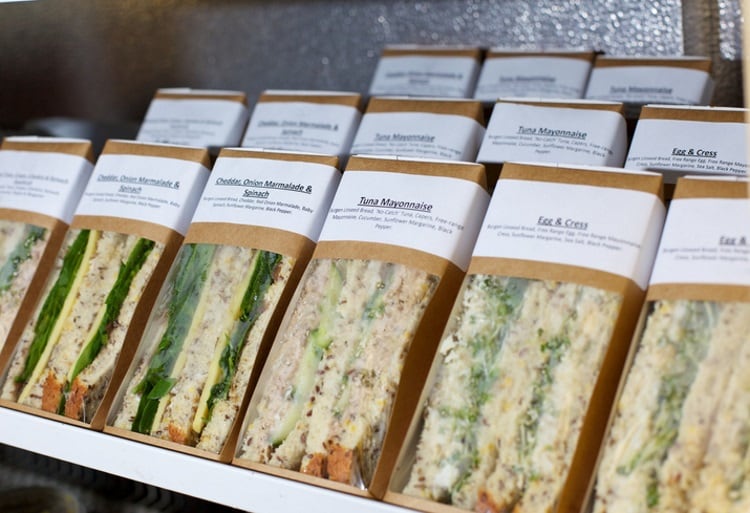Key takeaways:
- Climate pressures and global competition are forcing bakers to rethink their reliance on almonds.
- Classics like the Cherry Bakewell can keep their identity through careful almond-free reformulation.
- Nut-free flavorings, seeds and composite solutions are now viable tools for managing flavor, texture, and supply risks.
For decades, almonds have been a dependable ingredient for bakers – from the frangipane in a Cherry Bakewell to the marzipan in a stollen. But in 2025, that certainty is wavering. Prices are unstable, supply is uneven and the official outlook is being questioned.
The USDA’s latest Objective Measurement report projects California’s crop at 3 billion pounds, about 10% above last year. Growers are pushing back, saying the forecast glosses over the reality on the ground. After years of tight margins, many have cut back on orchard inputs, while heat and poor water quality have left trees under stress. And because California grows roughly 80% of the world’s almonds, even a small drop in output there can quickly lift prices and throw bakery production schedules off balance.
Almond market by the numbers
USDA 2025 forecast: 3.0bn lbs vs. 2.72bn in 2024 – up 10%
Grower estimate confidence: Low, citing heat stress, poor water quality, reduced inputs
California share of global supply: ~80%
Bearing acreage: Flat at ~1.39m acres
Non-bearing acreage: Down from 0.31m in 2023 to 0.26m in 2025
Shipments: Domestic shipments soft; exports holding steady
Market value: $8-$13bn globally
Key competitor sectors: Snacks, bakery, plant-based dairy
Tradition under pressure

When an ingredient like the almond wobbles, heritage products feel the impact first. The Cherry Bakewell is one of Britain’s best-loved bakes – shortcrust pastry, a layer of jam, almond-rich frangipane, smooth icing and a bright glacé cherry on top.
Its roots go back to the early 1800s in Bakewell, Derbyshire, where legend has it a cook at the White Horse Inn accidentally created the softer Bakewell pudding. By the end of the century, bakers had refined it into the tart we know today, keeping the jam and almonds but giving it a crisper base. The iced Cherry Bakewell with its single glacé cherry topping is a mid-20th century invention, popularized by commercial bakers such as Mr Kipling.
For Kirsty Matthews, brand manager at ingredient specialist Macphie, the heritage is precisely why the current almond situation matters. “The Cherry Bakewell isn’t just a cake – it’s a part of British culture,” she says. “People have a fixed idea of how it should taste, how it should feel when you bite into it. That’s what makes changing the ingredient list so sensitive.”
Yet Matthews says the company’s nut-free Cherry Bakewell Sensation – which delivers the same cherry-and-almond profile without using almonds – has seen a surge in demand. “Customers who’ve known us for years are suddenly seeing it as a solution for supply chain stability, not just allergy safety. And we’re reaching people who’ve never been able to enjoy the flavor before because of a nut allergy. That’s incredibly rewarding.”
She’s clear that removing almonds doesn’t mean losing the Bakewell. “We can still give you the experience you expect – the same aroma, the same balance of flavors, the same indulgence – but with an ingredient list that works in today’s supply climate.”
Reformulation as resilience
Reformulation used to happen only when there was no choice. Now, it’s part of long-term strategy. Matthews says that’s because supply volatility, ingredient costs and allergen legislation like Natasha’s Law are making forward planning more complex.
At Macphie, the first priority is flavor authenticity. “We work with flavor houses to match the almond profile so closely that most people wouldn’t know the difference. That gives us a foundation to then solve for texture, which is harder. Almonds have a unique bite and oil release – you can’t just throw in a seed and hope for the best. We’ve trialed different inclusions to give a subtle crunch where it’s expected.”
She notes reformulation also strengthens allergen management. “If you can remove an allergen without losing flavor or performance, you make life easier for chefs, caterers and manufacturers. We did it with our celery-free demi-glace, and it simplified production and widened our customer base. With almonds, you also get the benefit of reducing exposure to market volatility. It’s about protecting both quality and continuity.”
This almond issue, she adds, is not unique. “We’re watching cocoa, vanilla, certain citrus – all ingredients that could be disrupted by weather, disease or trade shifts. If you’re tied too closely to a single, vulnerable input, you put the whole product at risk. That’s the reality now.”
The market outlook

The global almond market is worth between $8 billion and $13 billion, with growth driven by snacks, bakery and plant-based dairy. Plant-based dairy is a powerful competitor for raw supply, often locking in long-term contracts that leave smaller bakery buyers fighting for what’s left.
Although California sets the tone for the global market, the UK’s supply isn’t exclusively American. Spain is the EU’s largest almond producer, with premium varieties like Marcona used in high-end confectionery and bakery. Australia has also become a reliable producer, supplying around 7%-8% of global output. But volumes from these origins are small compared with the US, and prices are interconnected. A shortfall in California still ripples quickly through Spain and Australia, meaning UK buyers feel the impact regardless of origin.
The USDA’s forecast will be tested as the harvest wraps up. If it’s overstated, prices could tighten into early 2026, just as bakers plan for spring runs. With orchard removals continuing and fewer young plantings coming through, production won’t climb without serious investment in water-secure land. Trade tensions could tip the balance further.
For Matthews, the path forward is about flexibility. “We’re not losing the Cherry Bakewell. But we are being challenged to think differently about what goes into it. And in doing so, we open the door to a more resilient and resourceful future for baking. That’s what will separate the brands that thrive from those that simply cope.”
Almond alternatives for bakers
Bakers facing almond shortages aren’t short on options – the challenge is finding one that keeps both the flavor and the texture customers expect.
Some are turning to nut-free almond flavorings from specialist houses, which recreate the signature aroma without a trace of nuts, keeping recipes allergen-safe and insulated from supply swings.
Others are swapping in roasted sunflower or pumpkin seeds for a mild, nutty crunch; or crisped grains like rice, quinoa or barley to add light texture without changing the flavor too much.
For a protein boost and a more unusual texture, roasted chickpeas or lupin seeds can be milled or chopped as inclusions.
Where allergen concerns aren’t an issue, hazelnuts or cashews can fill the gap, though they bring their own distinct taste and market volatility.
Some bakers are finding success with composite solutions – blending a seed or grain for bite with a nut-free flavoring for aroma – to create a near-indistinguishable result in frangipane and other almond-based bakes.





